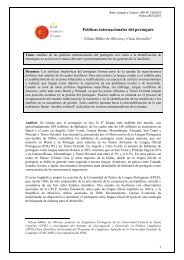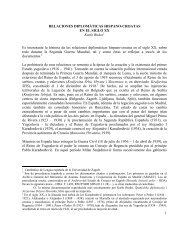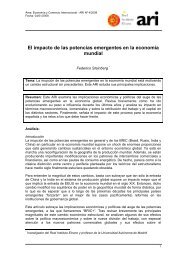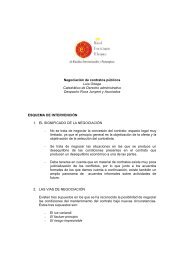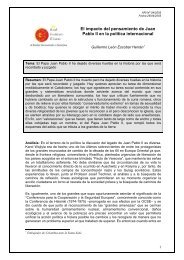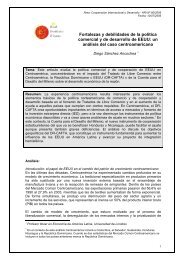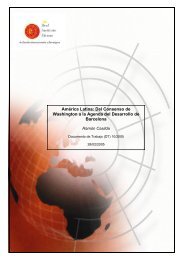Spain and the United States - Real Instituto Elcano
Spain and the United States - Real Instituto Elcano
Spain and the United States - Real Instituto Elcano
You also want an ePaper? Increase the reach of your titles
YUMPU automatically turns print PDFs into web optimized ePapers that Google loves.
CHAPTER 5<br />
THE HISPANIC COMMUNITY<br />
Hispanic power is on <strong>the</strong> rise in <strong>the</strong> <strong>United</strong> <strong>States</strong>, <strong>and</strong> <strong>the</strong> consequences of it<br />
could be beneficial for <strong>Spain</strong>.<br />
The number of Hispanics – more than 41 million at <strong>the</strong> last official<br />
count – surpasses <strong>the</strong> total population of <strong>Spain</strong>. 1 The Hispanic community is<br />
growing more than three times faster than <strong>the</strong> US population as a whole; in<br />
2003 Hispanics surpassed African Americans as <strong>the</strong> <strong>United</strong> <strong>States</strong>’ largest<br />
minority group.<br />
This community is demographically, politically <strong>and</strong> economically an<br />
increasingly important force; however, despite <strong>Spain</strong>’s historic links with <strong>the</strong><br />
<strong>United</strong> <strong>States</strong> <strong>and</strong> a long presence in <strong>the</strong> country (1513-1822, see Chapter 1),<br />
Madrid <strong>and</strong> Spanish society in general only recently began to take notice of it.<br />
Demographically, Hispanics account for more than 14% of <strong>the</strong> total US<br />
population. Between July 1, 2003 <strong>and</strong> July 1, 2004 <strong>the</strong>y were responsible for<br />
about one-half of <strong>the</strong> national population growth of 2.9 million. Of <strong>the</strong> 17%<br />
rise in <strong>the</strong> Hispanic population between 2000 <strong>and</strong> 2004, 55% was due to births<br />
in <strong>the</strong> <strong>United</strong> <strong>States</strong> <strong>and</strong> 45% to immigration (see Exhibit 5.1). Economically,<br />
Hispanics’ purchasing power is more than $700 billion, <strong>and</strong> by 2010 it will<br />
probably reach a trillion dollars (<strong>Spain</strong>’s GDP reached that figure in 2005).<br />
Politically, Hispanics are gaining ground: <strong>the</strong> Senate, for <strong>the</strong> first time, has two<br />
Hispanic senators, Mel Martinez (Republican) <strong>and</strong> Ken Salazar (Democrat);<br />
<strong>the</strong>re are 25 Hispanics in <strong>the</strong> House of Representatives (out of a total of 435<br />
<strong>and</strong> compared with 21 in <strong>the</strong> first administration of George W Bush); Bush’s<br />
Attorney General <strong>and</strong> Commerce Secretary are both Hispanics; Bill<br />
Richardson, <strong>the</strong> governor of New Mexico, is partly Mexican; Los Angeles, <strong>the</strong><br />
1. <strong>Spain</strong>’s population was more than 44 million in 2005. The last (July 1, 2004) official figure for<br />
Hispanics in <strong>the</strong> <strong>United</strong> <strong>States</strong> of 41.3 million excludes <strong>the</strong> nearly 4 million inhabitants of <strong>the</strong> Free Associated<br />
State of Puerto Rico, where both Spanish <strong>and</strong> English are <strong>the</strong> official languages, <strong>and</strong> undocumented workers<br />
(more than 8 million are from Latin American countries according to <strong>the</strong> Pew Hispanic Centre).



